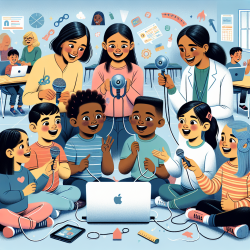Introduction
As the landscape of therapy continues to evolve, online platforms have emerged as a pivotal tool for delivering services to diverse populations. The research article "Working Across Differences While Online: Examining the Experience of Facilitating a Virtual Group" offers valuable insights into the complexities and opportunities inherent in virtual group facilitation. This blog post aims to distill key findings from the study to help practitioners enhance their skills and foster better outcomes for children and adolescents in online settings.
The Power of Virtual Group Facilitation
Virtual group facilitation has become an essential mode of counseling, particularly in reaching clients who may face barriers to accessing in-person services. The study highlights the potential of online group counseling to deliver comparable outcomes to traditional face-to-face interactions. However, it also underscores the unique challenges faced by facilitators, especially when working with clients from diverse sociodemographic backgrounds.
Key Challenges and Strategies
The research identifies several challenges encountered by facilitators in virtual settings, including:
- Barriers to Cohesion Building: The inability to see participants' facial expressions and body language can hinder the development of group cohesion. Facilitators must adapt by utilizing features like chat and interactive tools to foster engagement.
- Difficulty with Power/Oppression Discussions: Addressing sensitive topics related to identity and oppression can be challenging in a virtual environment. Facilitators need to be mindful of their own identities and the potential impact on group dynamics.
- Adjusting Tactics and Expectations: Facilitators should be prepared to modify their approaches, using a variety of communication tools and setting clear expectations for participation from the outset.
Implementing Effective Practices
To enhance virtual group facilitation, practitioners can consider the following strategies:
- Promote familiarity with online tools such as chat, whiteboards, and polls to encourage active participation.
- Engage in ongoing check-ins with group members to assess satisfaction and adapt strategies as needed.
- Facilitate open discussions about the unique dynamics of virtual settings, normalizing the experience and building trust.
- Be aware of and address any personal biases or assumptions that may affect interactions with clients from different backgrounds.
Conclusion
As online therapy continues to expand, practitioners must be equipped with the skills and knowledge to navigate the complexities of virtual group facilitation. By embracing data-driven strategies and fostering inclusive environments, therapists can create meaningful and impactful experiences for their clients. For those interested in delving deeper into the nuances of this study, the original research paper can be accessed here: Working Across Differences While Online: Examining the Experience of Facilitating a Virtual Group.










